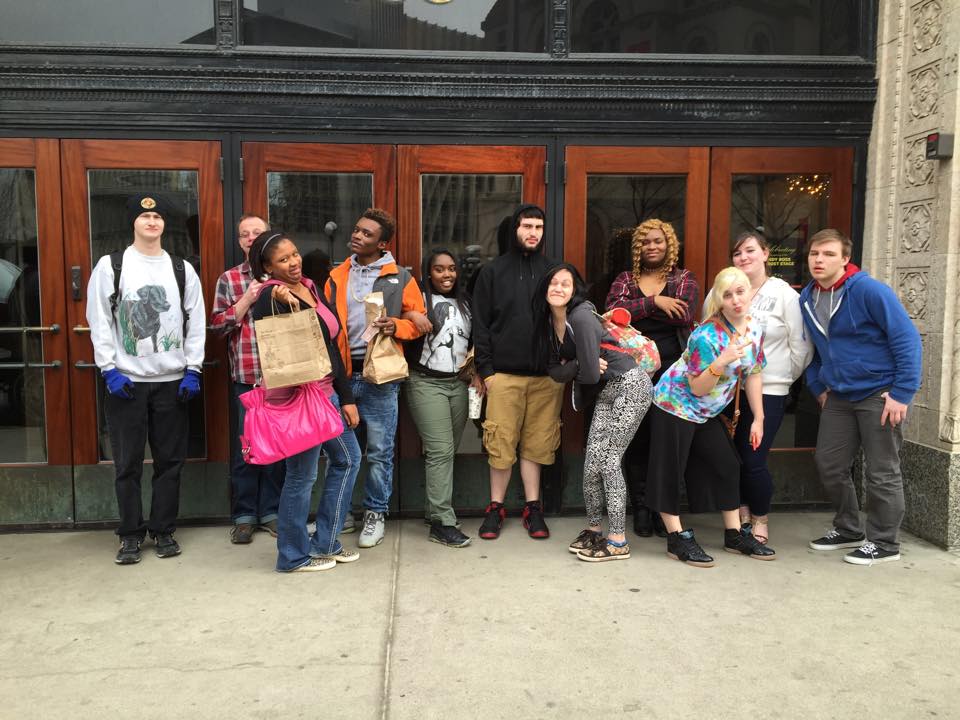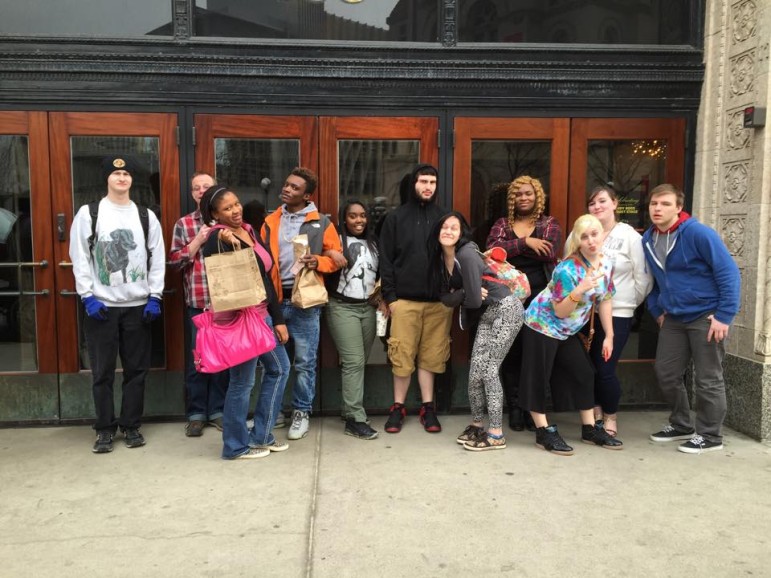
Photos courtesy of Paladin Career and Technical High School
Paladin students on a field trip to Minneapolis to see the play “Romeo and Juliet.”
From ACEs Too High News:
When it’s spring break at many high schools, most kids and teachers can’t wait to get away from school with their families for a week.
Not so at Paladin Career and Technical High School in Blaine, Minn., outside Minneapolis.
“The week before break the level of anxiety gets pretty extreme around here,” says Leisa Irwin, executive director of Paladin. “It’s the same before any holiday break.”
The kids don’t want to leave … for good reason. There’s nothing fun or relaxing about spending a week at home. Most students come from homes and neighborhoods filled with violence, alcohol and drug abuse. They live with families where humiliation, neglect, mental illness and hopelessness are part of everyday life. A stark 34 percent of Paladin students are homeless; they hang out on dangerous streets for a week in cold weather. The school is their haven.
So the school, which is located in a mall, stays open, and kids drop in all week long, says Irwin. “There’s always somebody here; we’re always here for the kids.”
That approach represents just one small way in which Irwin changed the school to give the students what they need to be successful, instead of forcing the kids to comply with a traditional education system that, until they found Paladin, made their lives even more difficult.
“Education’s in serious trouble,” says Irwin, because most people think that the best way to help a kid who’s not succeeding in school is to provide them tutoring or kick them out if they cause enough trouble.
“There isn’t enough tutoring in the world to fill gaps in these kids,” she says. “It’s not about tutoring, it’s about how to help students focus on education.” And to do that, she and her staff first had to create a safe environment, build trust between students and their teachers and staff, create a different way for kids to learn and assess their progress in a very different way.
The results? Remarkable. Graduation rates up over 30 percent. The number of students planning to attend a two- or four-year college increased from 16 percent to 84 percent in three years. Suspensions are rare, due to the restorative justice program, and, in the last three years, there have only been three expulsions.
But it’s not just these numbers that are measures of success, says Irwin, who somehow wraps high energy, a no-nonsense attitude and extreme caring into one ebullient personality. It’s much, much deeper than that.
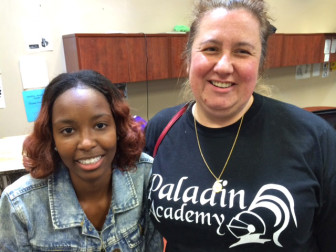
Senior Robin Buckner (left) with Paladin executive director Leisa Irwin. Buckner is applying to a two-year college.
Irwin remembers the day that everything changed in her life.
An encounter with a student “forced me to identify the real issues facing the students at Paladin,” notes Irwin, and it was deeper than poverty, or if they were behind in their grade level, or if they were on probation, or if they were designated learning disabled because they were on a special education plan.
So in an effort to develop a schoolwide approach to dealing with the real issues that students were grappling with, Irwin and the staff spent the year digging into the lives of the students, to try to identify exactly what those issues were.
“The questions we asked,” explains Irwin, “included things like substance abuse, interactions with the legal system, single-parent homes, were the students living on their own, did they have children of their own, were there other adults involved in their lives, etc. And then we analyzed what we had learned, and started planning how we could address the issues at a schoolwide level.”
They developed a list of 15 risk factors that impede the ability of a student to engage in learning. These are:
- Free/reduced-price lunch eligibility (indicates economic poverty)
- Special education status (a defined learning, health or behavioral disability)
- Race (a minority student)
- Criminal record
- Gang affiliation
- Young parent (has one or more children)
- Home mobility — moved more than five times in their lives
- Educational mobility — attended three or more high schools
- Witness to many violent acts (in home, neighborhood or elsewhere)
- Crime victim
- Mental illness
- Homeless (currently, or persistently in the past)
- Suicidal
- Drug use (including alcohol)
- More than one year behind in high school
A few months after they developed this list, Irwin found out about the CDC-Kaiser Permanente Adverse Childhood Experiences (ACE) Study and related ACEs research. It was another profound moment for Irwin, because it explained much of her kids’ behaviors. The ACE Study showed a direct link between 10 types of childhood adversity and the adult onset of chronic disease, mental illness, violence and being a victim of violence.
Five of the types measured were personal — physical, verbal and sexual abuse, and physical and emotional neglect. Five were family dysfunctions: a family member incarcerated or mentally ill or addicted to alcohol or other drug, witnessing a mother being battered and losing a parent to divorce or separation.
The study found that of the 17,000 mostly white, middle-class, college-educated, Kaiser health-insured adults who participated in the ACE Study, nearly two-thirds experienced at least one type of severe childhood trauma. About 40 percent had suffered two or more. The study found that a person with four or more adverse childhood experiences is 12 times more likely to attempt suicide, 10 times more likely to inject street drugs, seven times more likely to be an alcoholic, 2½ times more likely to have a stroke and twice as likely to have cancer. The lifespans of people with ACE scores of 6 are shortened by 20 years. ACE studies have now been done in 29 states and Washington, D.C., with similar results.
Why this happens is explained by what happens when children experience trauma: Their brains instantly react by going into fight, flight or freeze mode. They produce an overload of stress hormones — such as cortisol and adrenaline — that actually harm the function and structure of their brain. This is called “toxic” stress.
If they have no safe adult living in a safe environment to rely on, children with toxic stress respond to the world as a place of constant danger. With their brains overloaded with stress hormones and unable to function appropriately, they can’t focus on learning. They fall behind in school, fail to develop healthy relationships with peers or create problems with teachers and principals because they are unable to trust adults. Some kids do all three.
With despair, anxiety, guilt, depression and frustration pecking away at their psyches, they often find solace in food, alcohol, tobacco, methamphetamines, violence, crime, inappropriate sex, high-risk sports and/or work and overachievement. They don’t regard these coping methods as problems. Consciously or unconsciously, they use them as solutions to escape … from depression, anxiety, anger, fear and shame.
This doesn’t excuse kids’ behavior, ACEs experts say, but the solution to helping them heal is to help them resolve their underlying issues instead of putting them in a system that further traumatizes them.
So, to the list of 15 risk factors, Irwin added the 10 types of ACEs. Paladin staff call these 25 risk factors the Benchmark for Success Obstacle Score, or ACEs Plus, and it’s used to evaluate each student.
The results are staggering, says Irwin. In the 2013-14 school year:
- 43 percent of the students lost a parent to divorce, abandonment or separation.
- 24 percent had a parent who’s been in prison.
- 41 percent had been homeless in the last five years.
- 11 percent had a child.
- 57 percent had used or are currently using drugs.
- 17 percent had used street drugs, such as meth or heroin.
- 50 percent had moved more than five times in their lives.
- 81 percent were at least two years behind in school.
- 33 percent had lived with people who abused alcohol or other drugs.
And, most telling: In the 81 percent of the students who were two or more years behind in school, 91 percent had an ACE score of five or more, and an ACE Plus score of 17 or more.
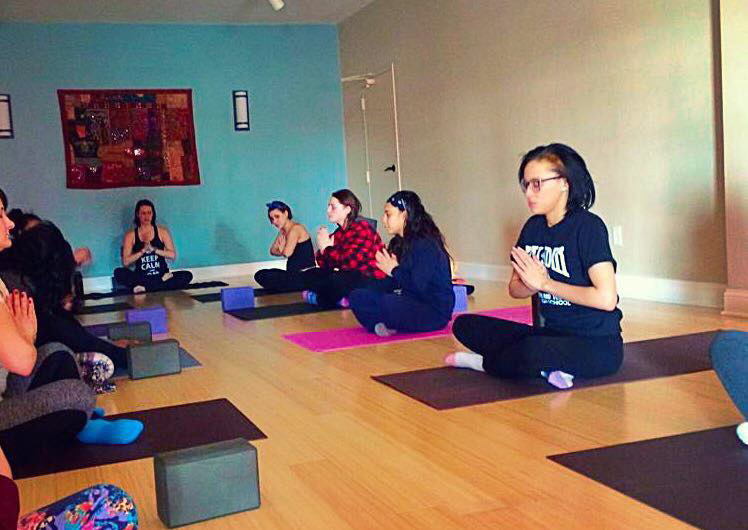
Yoga class at Paladin.
For many the free lunch at the school is the only food they eat in a day. Regardless of a student’s free or reduced-price lunch status, all students have access to free breakfast and lunch. The school has found that for the students who did not qualify for free or reduced-price meals, it was because they did not turn in their paperwork, and not because their family income was too high. Most of those using drugs or who had used drugs had received no treatment. And many with mental health issues were not receiving any followup care.
The students, by the way, are a diverse group: In the 2013-14 school year, 47 percent were white, 40 percent black, 9 percent Hispanic, 3 percent American Indian and 1 percent Pacific Islander. (In the 2014-15 school year, 50 percent were black, 45 percent white and 5 percent Hispanic.)
All this detailed knowledge about the students has helped shape the revolutionary approach Paladin takes to educating the students. So did learning about the changes that Lincoln High School, another alternative school in Walla Walla, Wash., had made. After learning about Jim Sporleder, who was then principal at Lincoln, and how he’d led the school to becoming trauma-informed and had seen his students blossom (89 percent drop in suspensions the first year, with grades, test scores, graduation rates going up), Irwin took heart that she wasn’t alone in her efforts. Now they are writing a book together.
First, administration, staff and teachers make sure that they’ve created a welcoming and safe place. Students, especially these students, can’t learn if they’re constantly on guard. This means making sure that the staff and teachers prevent bullying, that they understand a student’s triggers and do their best to intervene before a student erupts or withdraws.
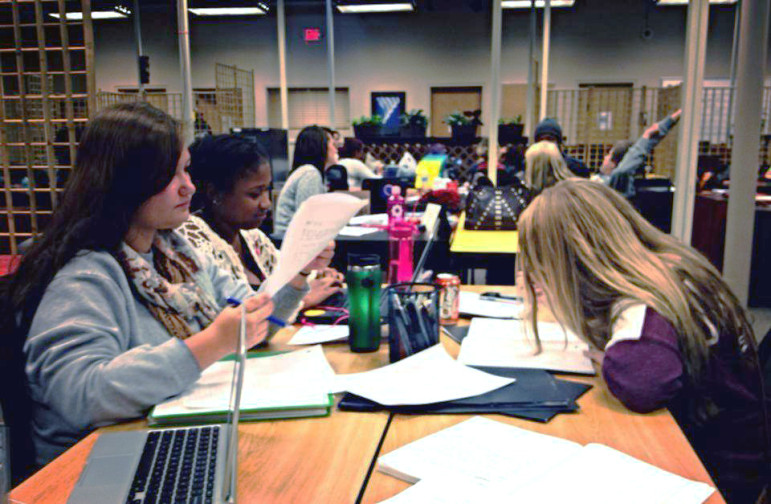
Paladin’s Learning Lab.
The school hires teachers and staff who have a deep understanding about trauma and adversity, and provides continuous training in these areas. When conflicts arise, the school uses a restorative justice approach to resolve problems.
The school also expanded its physical space and underwent a complete remodel, so that the dreary mall-like atmosphere changed into a vibrant learning environment.
Paladin is a project-based learning school, says Irwin. Students attend seminars of their choice, and complete projects to earn credit. They work with teachers who guide them in building problem-solving skills and managing workflow as they complete their projects.
“The benefit of project-based learning in this environment cannot be understated,” says Irwin, “we will never fully fill in the education gaps that were missed in the past 10 to 15 years of a student’s life, but we can teach students how to learn. We can teach them how to identify issues, use credible research, analyze results and make decisions. Those skills are transferable into any college or career, and will give these young people the tools they need to learn whatever it is they need to learn in the future.”
The school also identifies each student’s list of obstacles so that they can create an individual plan for the student. Each student is provided a student success coordinator who works with that student throughout their time at Paladin. In addition to tutoring and small-group learning, the supports provided a student may include counseling, medical care and food, clothing and shelter.
Because the students deal with so much adversity in their lives, the school decided to develop other measures of success besides test scores and grades. They settled on the Casey Life Skills, which focus on building skills, such as daily living activities, budgeting and paying bills, computer literacy and permanent connections to caring adults that imbue resilience in the kids. They also use the Hope Survey, which identifies how students feel about themselves and how they view their relationship with the community. These are all indicators of resilience, a key component to addressing adverse childhood experiences.
The school also educates the students about ACEs and resilience, and several students have focused their projects on some aspect of ACEs, such as drug abuse. The school has started an ACEs group comprising students and staff who develop plans to educate the community about ACEs and trauma-informed, resilience-building practices.
Irwin says that Paladin is now in year three of a five-year plan to “link specific interventions to specific obstacles with measureable outcomes.” In other words, to produce solid research that shows how their formula of designing a school to fit the needs of kids helps the kids more than traditional high schools.
See sidebar “A Trauma-informed School Wasn’t Part of My Plan, But Now It’s My Life’s Work”
This article was originally posted by ACEs Too High News.


